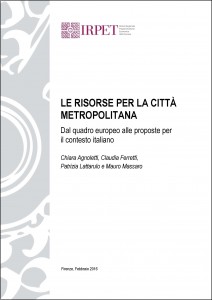 The establishment of Metropolitan cities has undoubtedly represented a considerable step in the ongoing process of reconsidering the present institutional architecture, a process which has also been fuelled by the need to obtain a stronger consistency between the real boundaries of communities and the formal boundaries of institutions. The several expectations are however surrounded by many uncertainties on the financial side, particularly as regards the independence of the new authority, which constitutes a still open question. Starting from these premises, the present research explores the different suggestions on how to increase the monetary autonomy of the newborn institution. These resources may derive from transferred functions and Community financing, while the principle of benefit and the international experience call attention to the category of city users and the presence of agglomeration economies. In fact, the Metropolitan City gains from the latter a number of advantages that determine a stronger concentration of income as compared to the rest of the region. Such advantages are enjoyed not only by the economy of the area but also by the population that gravitates towards the city, i.e. the city users. Finally, urban congestion, which can create negative externalities that are critical for development, must necessarily be controlled and its effects prevented.
The establishment of Metropolitan cities has undoubtedly represented a considerable step in the ongoing process of reconsidering the present institutional architecture, a process which has also been fuelled by the need to obtain a stronger consistency between the real boundaries of communities and the formal boundaries of institutions. The several expectations are however surrounded by many uncertainties on the financial side, particularly as regards the independence of the new authority, which constitutes a still open question. Starting from these premises, the present research explores the different suggestions on how to increase the monetary autonomy of the newborn institution. These resources may derive from transferred functions and Community financing, while the principle of benefit and the international experience call attention to the category of city users and the presence of agglomeration economies. In fact, the Metropolitan City gains from the latter a number of advantages that determine a stronger concentration of income as compared to the rest of the region. Such advantages are enjoyed not only by the economy of the area but also by the population that gravitates towards the city, i.e. the city users. Finally, urban congestion, which can create negative externalities that are critical for development, must necessarily be controlled and its effects prevented.
These basic principles have guided the examination of a few funding options which, with a view to the special features of the new authority and of its territory, are designed to involve both a share in revenues from the State or the participating Municipalities, thus leaving the tax return unchanged, and a new tax system at local level.
Author: Chiara Agnoletti, Claudia Ferretti, Patrizia Lattarulo (IRPET) e Mauro Massaro (Fondazione Cesifin)









